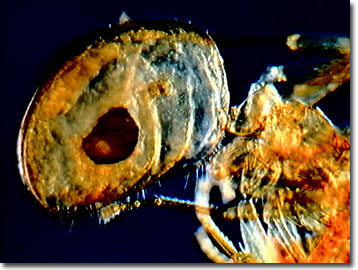Darkfield Digital Image Gallery
Ants (Formicidae)
One of the most successful insects to inhabit the Earth during the past 100 million years is the ant, a member of the class Insecta. Within the order Hymenoptera that also includes the wasps and bees, the 252 genera and more than 20,000 species of ants belong to a single family, Formicidae.

View a low magnification image of an ant.
Ants are cosmopolitan and distributed throughout the world, but are most common in the warmer climates. Termites, though similar to ants morphologically and in social structure, are not closely related. Rather, termites belong to the order Isoptera and are believed to be more closely related to cockroaches.
The social behavior of ants is one of the most complex and well studied of the insect world and is centered on a predominately matriarchal society made up of three castes. At the heart of each ant colony is the queen, a winged, fertile female responsible for laying all of the colony's eggs. Infertile females, called workers, gather food, protect the nest and the queen, and tend to the larvae and pupae. Males generally have wings for dispersal and are hatched along with new queens for the sole purpose of fertilizing them, dying soon thereafter.
Ants are capable of carrying objects up to 50 times their weight, equivalent to a human carrying a car, and as in the fable of the ant and the grasshopper, are considered hard workers. Two of the most dangerous groups, the army ants and driver ants, are found in South America and Africa, respectively. These ants swarm in groups of 10,000 to over a million in search of food, and destroy anything in their path. They have even been known to kill large animals (such as horses) that are unlucky enough to cross their deadly path.
Discovered during the 1920s, and introduced to the United States from South America, exotic red fire ants, Solenopsis invicta, can inflict painful bites and sometimes-deadly stings, particularly when swarming. Additional threats from the aggressive nonnative hymenopteran include displacing native ant species and their predators such as Texas horned lizards ("horny toads"), and threatening rare and declining native species throughout its introduced range. This species also feeds on plants, destroying buds, seeds, and developing fruits, and "nurses" numerous aphid and scale insect species that damage crops. Millions of dollars and tons of toxic pesticides have been expended fighting the noxious insect for more than 50 years, but it continues to spread in range. One of the more unusual economic and safety threats posed by red imported fire ants is their attraction to electrical systems, and the fires and short circuits that result from their activities.
Contributing Authors
Cynthia D. Kelly, Thomas J. Fellers and Michael W. Davidson - National High Magnetic Field Laboratory, 1800 East Paul Dirac Dr., The Florida State University, Tallahassee, Florida, 32310.
BACK TO THE DARKFIELD IMAGE GALLERY
BACK TO THE DIGITAL IMAGE GALLERIES
Questions or comments? Send us an email.
© 1995-2025 by Michael W. Davidson and The Florida State University. All Rights Reserved. No images, graphics, software, scripts, or applets may be reproduced or used in any manner without permission from the copyright holders. Use of this website means you agree to all of the Legal Terms and Conditions set forth by the owners.
This website is maintained by our
Graphics & Web Programming Team
in collaboration with Optical Microscopy at the
National High Magnetic Field Laboratory.
Last Modification Friday, Nov 13, 2015 at 01:19 PM
Access Count Since September 17, 2002: 8331
Visit the website of our partner in introductory microscopy education:
|
|
